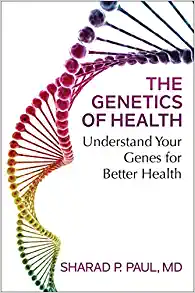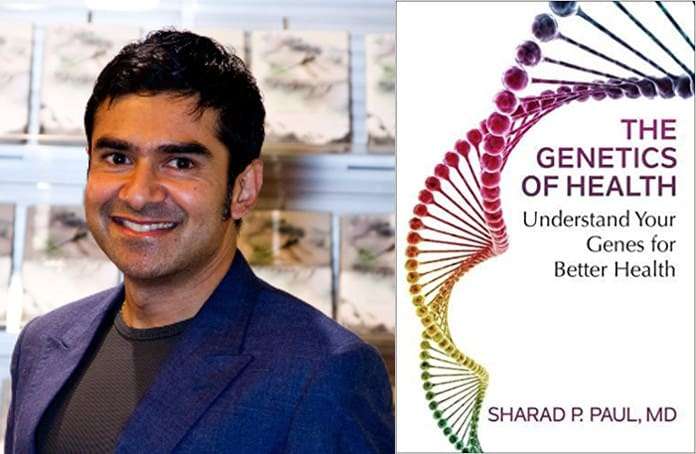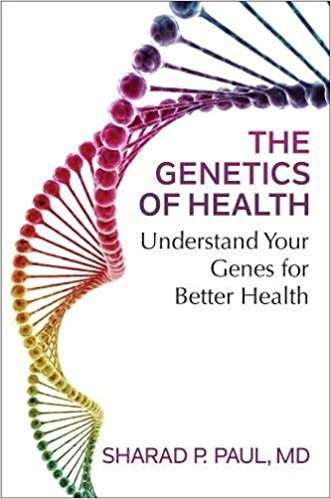Genetics of Health: Understand Your Genes for Better Health by Dr. Sharad Paul
For a sneak peek of Dr. Sharad Paul’s Genetics of Health: Understand Your Genes for Better Health (Atria Books, April 4, 2017) check out the excerpt below!
The Genetics of Health
EAT, MOVE, LIVE
In some ways, this book is a curated exposition of living well—a retrospective of guts, genes, and geography and their impact on good health—a brief history of human evolution, genetic restlessness, and the power of positive thought.
Western medicine has weapons that can torpedo tumors and vaccinate against viruses. Eastern medicine works on the energy of faith, using consciousness to bring wholesomeness to our individual bodily constitutions. Many years ago, I trekked in the Himalayas. My second novel, To Kill a Snow Dragonfly, was set in Tibet. The Tibetans have a concept of rLung—“wind” or “breath,” that has a remarkable philosophical equivalence to the Greek pneuma, Chinese qi, or Ayurvedic prana—life forces or vital energies that bind all life-forms. Tibetans use an elegant image of a tree to illustrate health—the tree of health has only two kinds of fruit and flowers, indicating good outcomes: the two flowers are said to be freedom from disease and increased longevity, and the fruits are spiritual and material well-being. In other words, without good health, there can be no happiness or enjoyment of material things.
Western medicine has a certain clinical detachment, a feeling that any application of science requires an absence of sentiment. Touching is strictly for examination. In Eastern medicine, touching is not necessarily a trespassing of boundaries but a natural human construct.
After all, touch is the only sense essential for being. The other senses—vision, hearing, taste, and smell—exist for well-being but are not essential for survival. Touch is indispensable for all life-forms. Even bacteria exhibit contact inhibition, a form of touch. A study done on the C. elegans worms showed that physical interaction with other worms improved growth and development.
In 1986, Tiffany Field and colleagues studied twenty preterm babies—one group received fifteen minutes of touch three times a day; the other group was not touched, in keeping with prevailing views about causing infections.1 The study showed that the touched group gained twice as much weight and were able to be discharged from the hospital earlier.
Decades ago, the psychologist Sidney Jourard had studied the importance of touch and advocated touch therapy. While his work gained popularity after his death, and touch and energy healing became widespread, touch and touch therapy do not stack up in double-blind controlled clinical trials. In fact, the youngest person to publish a paper in the prestigious JAMA, the eleven-year-old Emily Rosa, studied over two hundred energy healers and found more than half could not detect the presence or absence of a nearby body. In her study, healers put hands through a curtain and recorded when they felt Emily’s hand alongside theirs. This led to touch therapy being ridiculed by mainstream medicine. But do nondrug or nonsurgical interventions need to pass such rigorous scrutiny? Or is it a matter of faith? After all, a significant proportion of humanity believes in an unseen creator; where there is faith, there is hope. Faith matters. Humanity needs hope. Ultimately it isn’t about East or West, but our own individual responsibility, a sense of purpose about our own lives. Just as law isn’t always about justice, medicine isn’t always about health. Hope and faith are seeds that can give rise to change.
Ted Kaptchuk of Harvard Medical School continues to study the power of faith in clinical studies. I mentioned Ted’s migraine and acupuncture studies earlier. Pain is a good warning system, and placebos are useful as evolutionary mirrors held up to treat phantom pain.
We now know that placebo drugs cannot shrink tumors or eliminate viruses, but they can stimulate real physiological responses, from changes in heart rate and blood pressure to chemical activity in the brain, helping pain, depression, anxiety, fatigue, and even some symptoms of Parkinson’s. That’s why the power of the mind matters and the stress response is stupendous. Stress cannot cause a tumor, but it can make the outcome worse after you develop one, as I’ve seen in my patients. Stress is a powerful drug that we can use, if we learn toavoid it lingering for too long.
That’s why, as we noted in the chapters on stress and anxiety, these stress genes that endured evolutionary time actually ensured the survival of our species. So what’s wrong with harnessing our own finely honed psychological powers of persuasion toward physical or physiological ends? Faith, hope, and loving touch can translate to perceptual, authentic, and existential living.
When Darwin noted different skin colors in different continents, he didn’t realize the impact of our diets. Unlike animals, humans changed their diets due to climate, circumstance, and continental migration. After diets were accounted for, Inuit skin darkened over time and Baltic bodies lightened due to the need for vitamin D.
Buy this Book!
Amazon




